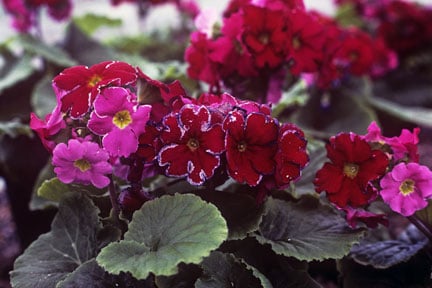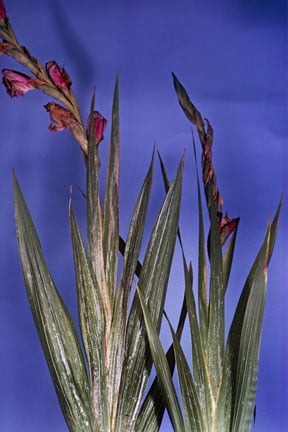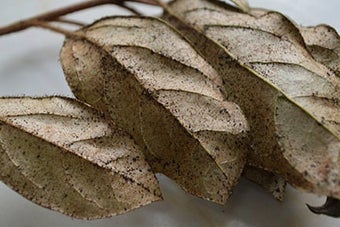
Quick facts
Scientific name - Insect order Thysanoptera
Plants affected - A wide range of plants can be affected
Main symptom - Mottled foliage and flowers
Most active - April-September
What are thrips?
Thrips (also known as thunder flies) are an order of insects, the Thysanoptera. Around 150 species are found in Britain. Whilst many feed by sucking from leaves and flowers many do not cause noticeable damage to host plants. A few species can however cause mottling to some garden and indoor plants.
Thrips vary in colour but otherwise show little obvious diversity in their appearance. The adult insects are narrow bodied and up to 2 mm in length. They have two pairs of strap-like wings, which are fringed with hairs, and these are folded back over the dorsal surface of the thrips when it is at rest. The immature (nymph) stages are wingless, generally creamy yellow and paler than the yellowish-brown or blackish-brown adults. There are several species of thrips that can cause damage in glasshouses and gardens.
Thrips can be hard to detect, shaking foliage over a white sheet of paper or similar can reveal the thrips which can then be examined, ideally with a magnifying lens.
Symptoms
Leaves fed upon by thrips often become dull green and later develop a silvery-white discolouration on the upper surface. The discoloured areas are usually marked by many tiny black excrement spots.
When thrips feed on developing tissues at the shoot tip or in flower they are can cause distorted growth. Flower petals are marked by a white flecking where the have been lost and heavy feeding damage may prevent flower buds from opening.
Some thrips, such as onion thrips and western flower thrips, can transmit plant viruses.
The problem
There are several species of thrips that can cause damage in glasshouses and gardens.
Gladiolus thrips (Thrips simplex) Mainly affects gladiolus during July to September, but also on freesia, causing white flecks on foliage and flowers. Heavy attacks cause the petals to turn brown and fail to open. To prevent overwintering thrips from feeding store corms in a cool frost-free place.
Pea thrips (Kakothrips pisivorus) Found on garden peas during June to August; causes stunted growth with a silvery brown discolouration on the foliage and pods; the latter may remain flat with just a few peas developing at the stalk end.
Privet thrips (Dendrothrips ornatus) The adults are brownish-black with a banded appearance of white and dark markings on their wings. They feed on the leaves of privet and lilac during May to October, resulting in the gradual development of silvery-brown foliage by late summer, and may cause some premature defoliation.
Banded palm thrips (Parthenothrips dracaenae) Occurs all year round on various glasshouse and houseplants, especially those with relatively tough leaves such as Ficus, Dracaena, Citrus, Monstera, Schefflera and palms. A blackish-brown thrips with banded brown and white wings that causes extensive silvering of the leaves.
Western flower thrips (Frankliniella occidentalis) A North American species present in Britain since 1986. Feeds on the foliage and/or flowers of many glasshouse plants, especially tomato, cucumber, streptocarpus, African violet, fuchsia, gloxinia, achimenes, pelargonium, cyclamen, chrysanthemum, verbena, Primula obconica and Impatiens. Feeding causes silvering of the leaves, stunted growth, flecking and premature senescence of flowers. When buying houseplants, check the flowers carefully and avoid any showing signs of thrips or pale flecking on the petals.
Onion thrips (Thrips tabaci) Causes a whitish mottling on the leaves of onion and leeks. It also feeds on a wide range of other plants, including carnation, chrysanthemum, begonia, cyclamen, dahlia, tomato and cucumber. It causes silvering of the foliage and on some plants, such as dahlia, feeding at the shoot tips results in severely stunted growth and distorted leaves.
Honeysuckle thrips (Thrips flavus) Found on many garden plants but is most frequently found on honeysuckle during May to October. The foliage becomes extensively silvery-brown, especially on honeysuckles growing in warm sheltered situations, such as against a wall.
Glasshouse thrips (Heliothrips haemorrhoidalis) Occurs in heated glasshouses throughout the year, causing a silvery discolouration of the upper leaf surface of many plants. The foliage is also marked with small brownish spots caused by the thrips' excrement. The adults are blackish-brown with yellowish-brown nymphs. This thrips can also survive out of doors all year round and feed on various garden shrubs, especially Viburnum tinus.

Management
If you encounter this insect on indoor plants then please consult our page on indoor plants: sap feeders for indoor specific advice.
- Tolerate some thrips damage, despite extensive silvery mottling established outdoor shrubs will usually survive the presence of glasshouse thrips
- Encourage natural enemies in gardens, for example the predatory bug Orius laevigatus can occur naturally
- Biological controls are available for use in glasshouses. These include a predatory bug (Orius laevigatus) and mites (Amblyseius species, Hypoaspis species and Macrocheles roibustulus (sold as Mighty Mite)). There is also a nematode biological control sold as Fruit and Vegetable Protection. The nematodes can potentially affect other insects and the predators can feed on invertebrates other than thrips. These can be purchased from biological control suppliers (downloads pdf document)
- Hanging blue sticky traps (widely available from garden suppliers) above or among the plants in glasshouses can trap thrips and help monitor and reduce numbers. This is not recommended out of doors as the traps will capture a large number of non-target invertebrates
Downloads
Biological control suppliers (pdf document)
Biology
A typical thrips will lay up to 100 eggs at a rate of one or two per day. These are often deposited on the younger leaves or in flower of host plants. Eggs hatch into nymphs which, like the adult insects, feed by sucking . There are two feeding nymphal stages before they go into pre-pupal and pupal stages. These non-feeding stages take place in the soil and/or in sheltered places on the host plant. The feeding nymphs are entirely wingless; wing buds are present on the pre-pupal and pupal stages, although wings are not fully formed until the adult thrips emerge.
The length of the life cycle varies and is affected by temperature. Under ideal conditions the life cycle is completed in 24-35 days and thrips in glasshouses may continue breeding throughout the year. Thrips on garden plants usually have two or three generations a year but may have more during hot summers. Outdoor thrips overwinter as adults or nymphs, either in the soil or concealed on the host plant.










